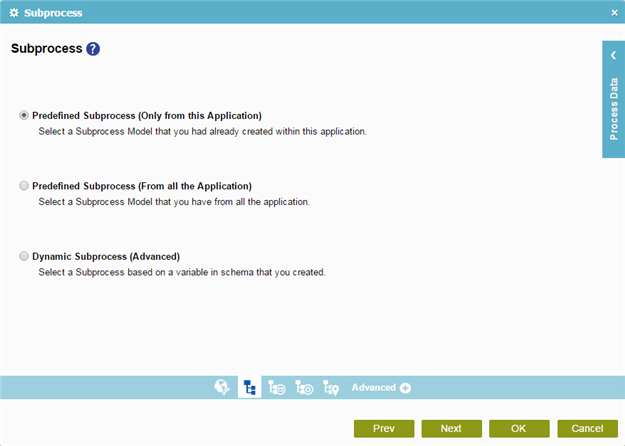Configure a Subprocess
To configure a subprocess, do the procedure in this topic.
Subprocess Screen

Good to Know
- In most text fields, you can use process data variables as an alternative to literal data values.
How to Start
- On the Organizer, do one of these:
- Do one of these:
- Add an activity:
- In the Process Builder, in the Activity Library, open the Common
 tab.
tab. - On the Common
 tab,
drag the Subprocess
tab,
drag the Subprocess  activity onto your process.
activity onto your process.
- In the Process Builder, in the Activity Library, open the Common
- Change an activity:
- In your process, double-click your activity.
- Add an activity:
Procedure
- Complete the fields on the
General Configuration screen.
For more information, refer to Configure General Options for a System Activity.
- Click Subprocess
 .
. - You can call a On the Subprocess
screen, do one of these:
- To use a specified process model for your subprocess, do this procedure.
- Select Predefined Subprocess (Only From This Application) or Predefined Subprocess (From All The Application).
- Click Subprocess Template
 .
. - On the Subprocess Model screen, in the Subprocess Model field, select the process from the list.
- Click Subprocess Configuration
 .
. - On the Subprocess Configuration screen, do this procedure.
- To specify the format for the name of the subprocess, do one of these:
- To use the name of the process model to create the process instance name, in the Subprocess Instance Name Format field, select Name .
- Select Custom to specify a different format.
In the Custom field, enter the name of the process, or drag a process data variable from the Process Data screen.
- (Optional) To add a GUID to the custom subprocess name, select If the subprocess name already exists, append the name with @${GUID}.
- To specify the name of the process that starts the subprocess, do one of these:
- To let the parent process start the subprocess, in the Subprocess Initiator Name, select Process Initiator.
- To let a different process start the subprocess, select Custom.
In the Custom field, enter the name of the process, or drag a process data variable from the Process Data screen.
- To specify the format for the name of the subprocess, do one of these:
- Click Subprocess Mapping Attributes
 .
. - On the Mapping Attributes screen, do one of these:
- :
- Select Map Specific Attributes (Advanced).
- Click Schema Mapping
 .
. - On the Schema Mapper screen, drag the variables from parent process model schema to child process model schema as necessary to connect them.
- :
- To dynamically select a process model based on a variable, do this procedure:
- Select Dynamic Subprocess (Advanced).
- Click Subprocess Configuration
 .
. - On the Subprocess Configuration screen, do this procedure.
- In the Subprocess Model field, enter the name of the process, or drag a process data variable from the Process Data screen.
- To specify the format for the name of the subprocess, do one of these:
- To use the name of the process model to create the process instance name, in the Subprocess Instance Name Format field, select Name .
- Select Custom to specify a different format.
In the Custom field, enter the name of the process, or drag a process data variable from the Process Data screen.
- (Optional) To add a GUID to the custom subprocess name, select If the subprocess name already exists, append the name with @${GUID}.
- To specify the name of the process that starts the subprocess, do one of these:
- To let the parent process start the subprocess, in the Subprocess Initiator Name, select Process Initiator.
- To let a different process start the subprocess, select Custom.
In the Custom field, enter the name of the process, or drag a process data variable from the Process Data screen.
- .
- Click Initial Attributes
 .
. An initial attribute is a process data variable in a subprocess that is populated with a value from the parent process when the parent process starts the subprocess.
- On the Initial Attributes screen, in the Name field, enter the name of a variable to connect with a subprocess.
- In the Value field, enter the value for the attribute, or drag a process data variable from the Process Data screen.
The value in the child process is connected to the variable in the parent process.
- To add more attributes, click Add
 .
.
- Click Initial Attributes
- To use a specified process model for your subprocess, do this procedure.
